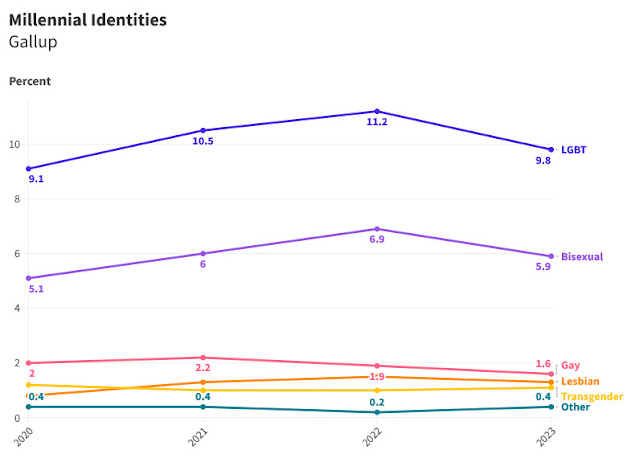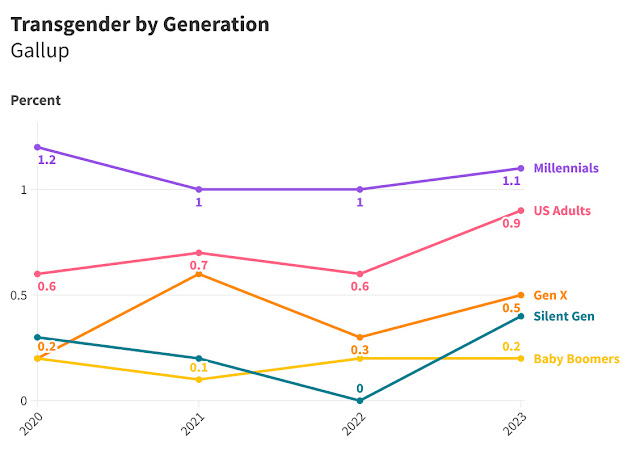(This article is the eighth in a series about Gallup's latest LGBT survey, which I began publishing in March.
The series is the second season of LGBT by the Numbers.
You can find brief descriptions of the articles from the first season in its Table of Contents.)
Gallup’s annual poll on LGBT identity in the US has revealed an interesting generation pattern.
Younger people are more likely to identify as LGBT.
This pattern is so strong that every year, each generation has a higher proportion of LGBT people than the generation that came before.
Today, we’re going to take a closer look at the generational data from Gallup’s annual poll.
We’ll examine each generation, individually, and view the percent of respondents from that generation who identify with specific LGBT identities.
We’ll also see how those values have changed over the past four years.
US Adults
Let’s begin by looking at US adults as a whole.
This graph represents the percent of US adults who identified as LGBT in Gallup’s annual survey, for each of the past four years. It also contains lines for specific LGBT identities.
A version of this graph first appeared in “Specific Identities,” an article I published in March.
All graphs in this article were created using Flourish, a website that allows users to create captivating visual aids.
The line for “Other” represents volunteered responses, such as pansexual and asexual, not specifically listed in Gallup’s question.
The percent of US adults who identify as LGBT appears to track fairly well with the values for bisexual.
Many of the graphs in this article have lines that are hard to see because they are significantly smaller than lines above them.
When that happens, I will publish additional graphs that omit lines with larger values, so we can see the other lines more clearly.
This graph shows the percent of US adults who identify with specific LGBT identities.
As you can see, bisexual is consistently the largest LGBT identity, by far.
The percent of US adults who identify as bisexual has increased every year since 2020.
The order of the identities remains consistent from year to year.
From largest to smallest, they are bisexual, gay, lesbian, and transgender.
Each year, fewer US adults provide volunteered responses than identify with any of these four identities in Gallup’s survey.
Let’s zoom in one more time, and take a closer look at the lines for gay, lesbian, and transgender.
As you can see, over the past four years, the percent of US adults who identify as gay has largely remained the same.
The percent of US adults who identify as lesbian and transgender, however, have both increased.
For each set of graphs in this article, I’ll provide the table of values I used to create them.
Gen Z
Now, let’s take a look at graphs for each generation, individually.
Gen Z has the highest percent of respondents who identify as LGBT.
Gen Z adults were born from 1997 to 2005. They were 18 to 26 in 2023.
This graph first appeared in, “LGBT Identities by Generation,” which I published in March.
Pay attention to the scale of the Y-axis for the graphs in this article, as their scales will vary significantly.
This graph has the largest scale of any of the graphs in this article.
As you can see, the total values for LGBT identity among Gen Z adults tracks fairly well with the values for bisexual.
This graph, which only includes specific identities, demonstrates how much larger the values for bisexual are than the values for everything else.
In the final Gen Z graph, let’s zoom in on the lines at the bottom.
As you can see, the order of gay, transgender, and lesbian identities among Gen Z adults changes from year to year.
The line for “other” represents volunteered responses not specifically listed in Gallup’s question, such as pansexual and asexual.
The line for volunteered responses is consistently smaller than the values for other identities.
That might sound obvious, but it isn’t true for all of the generations we are going to examine today.
Each specific LGBT identity has seen a net increase among Gen Z adults from 2020 through 2023.
Volunteered responses have seen a net increase during this time as well.
Millennials
Next, let’s take a look at LGBT identities among Millennials.
Millennials were born from 1981 to 1996. They were 27 to 42 in 2023.
This graph first appeared in “LGBT Identities by Generation,” which I published in March.
As you can see, the percent of Millennials who identify as LGBT tracks fairly well with the percent of Millennials who identify as bisexual.
This graph shows the prevalence of specific LGBT identities among Millennials.
Bisexual is consistently the most common LGBT identity among Millennials, by a significant margin.
The gap is about the same as the gap between bisexual and everything else among US adults as a whole.
By contrast, the gap between bisexual and everything else for Millennials isn’t as high as it is for Gen Z adults.
Now, let’s zoom in again, excluding the line for bisexual.
Gay is consistently the second most common LGBT identity among Millennials.
For the past three years, more Millennials have identified as lesbian than transgender.
But in 2020, more Millennials identified as transgender than lesbian.
The line for volunteered responses is consistently smaller than the other lines on the graph.
Gen X
Next, let’s examine Gen X, the first generation we haven’t thoroughly discussed earlier in this series.
Gen X was born from 1965 to 1980. They were 43 to 58 in 2023.
Gen X is the only generation with a consistent order of LGBT identities.
Bisexual is always the largest, followed by gay, lesbian, transgender, and volunteered responses, in that order.
This is the same order the identities have among US adults as a whole.
This graph only shows specific LGBT identities for Gen X.
Interestingly, the values for bisexual, gay, lesbian, and transgender all went down in 2022.
The values for all four went up in 2023. The value for volunteered responses also went up in 2023.
If you look back at the first Gen X graph, you’ll see the consistent decrease in 2022, and increase in 2023, had a significant impact on the total LGBT values.
Baby Boomers
Now, let’s look at the Baby Boomers.
Baby Boomers were born from 1946 to 1964. They were 59 to 77 in 2023.
Here is the graph for Baby Boomers that only shows specific identities.
Among Baby Boomers, gay is consistently the largest LGBT identity.
This is different than Gen Z, Millennials, and Gen X, where bisexual is the largest LGBT identity.
Ignoring occasional ties, the order of identities among Baby Boomers, from largest to smallest, are gay, lesbian, bisexual, transgender, and volunteered responses.
In 2021 and 2022, lesbian and bisexual were tied at 0.7%.
In 2021, transgender and volunteered responses were tied at 0.1%.
In 2022, transgender and volunteered responses were tied at 0.2%.
Notice how small the scale has become.
1.2% of Baby Boomers identified as gay in 2020.
In the last four years, that’s the only specific LGBT identity among Baby Boomers that has received more than 1%.
Silent Generation
The Silent Generation is the oldest generation in Gallup’s LGBT data.
The Silent Generation was born in 1945 or earlier. They were 78 and older in 2023.
The Silent Generation is the only generation that has seen a decrease, from 2020 through 2023, in the percent of respondents who identify as LGBT.
The percent of Silent Generation respondents who identified as LGBT decreased from 1.3% in 2020 to 1.1% in 2023.
In that time frame, all other generations have seen an increase in the percent of respondents who identify as LGBT.
This graph only shows specific LGBT identities among the Silent Generation.
The scale on this graph is incredibly small.
Among Silent Generation respondents, each specific LGBT identity has received less than 1% from 2020 through 2023.
Gay is always the largest identity, or tied for the largest identity, among the Silent Generation.
There aren’t clear patterns for the other values on this graph.
Conclusion
This article concludes my extensive analysis of the results of Gallup’s survey on LGBT identity in the US.
I would like to thank Gallup for conducting its annual LGBT poll, which provides the public with a treasure trove of information.
If you haven’t read all of the articles in the series, they’re worth checking out.
I plan to make a table of contents for the series, which I plan to publish soon.
Later this year, we should have the results of this year’s Gender Census, an annual global survey of nonbinary people.
Soon enough, we’ll have even more LGBT data to explore.
So make sure you check back on Meticulous Musings, as we continue our exploration of LGBT identity, by the numbers.
























%20.jpg)














